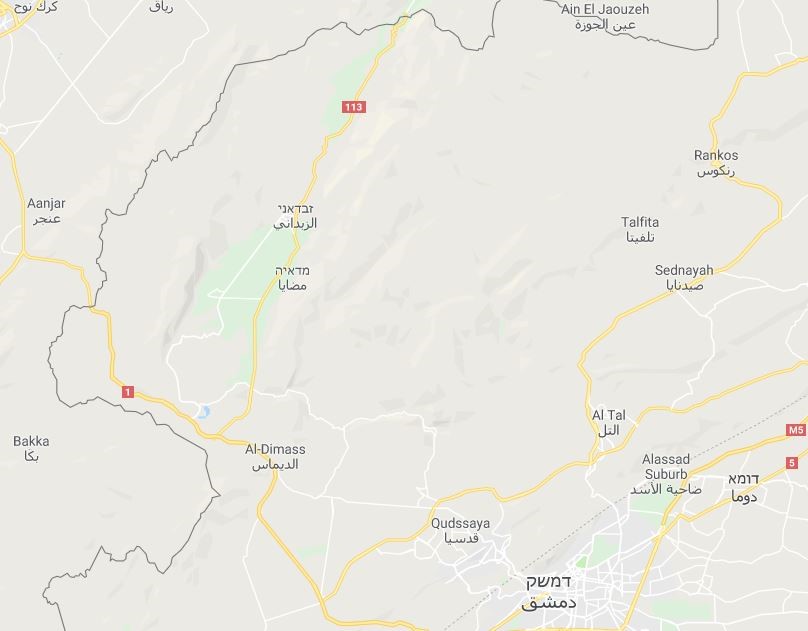The Lebanese Daily, Al-Modon: Hizbullah Controls Area In Syrian Territory Along Border With Lebanon – And Has Built Military Bases, Training Camps, And Underground Warehouses There
خريطة للمناطق السورية التي يحتلها حزب الله
MEMRI/November 20/18
A September 25, 2018 article in the Lebanese daily Al-Modon, which is known to oppose Hizbullah, surveys the deployment of Hizbullah forces on the Syrian side of the border with Lebanon. The article, by Ahmad Al-Shami, indicates that Hizbullah controls large areas of the western Rif Dimashq Governorate, including a strip along the border, 3km-5km long, and has cemented its presence in this area by establishing military bases, strategically-placed outposts, training camps, and underground warehouses. The article states further that over 1,500 Hizbullah operatives are deployed at over 100 military outposts in Rif Dimashq, and that one of these positions houses Iranian Islamic Revolutionary Guards Corps (IRGC) forces as well, and serves as an Iranian headquarters. According to the article, Hizbullah also derives economic benefit from its presence in this area by smuggling people, vehicles and goods across the border, and also by helping people to obtain a visa for Lebanon for a fee. It adds that one of the organization’s goals in controlling this area, which includes many Shi’ite villages, is to provide itself with a location for storing its weapons, should it become impossible to continue maintaining them in Lebanon.
The area in Syria controlled by Hizbullah according to the article (image: Google Maps).
The following are excerpts from the article:[1]
https://www.memri.org/reports/lebanese-daily-hizbullah-controls-area-syrian-territory-along-border-lebanon-%E2%80%93-and-has-built
“Although it expelled the [Syrian] opposition forces from western Rif Dimashq [Governorate] a year and a half ago, after a years-long siege, the Lebanese Hizbullah militia remains in isolated military outposts and many security compounds in a number of cities in western Ghouta, while the area controlled by the [Hizbullah] militia along the Syria-Lebanon border is 3km-5km long.
“According to an opposition military source, over 1,500 Hizbullah operatives are deployed in over 100 of the organization’s military outposts in western Rif Dimashq [Governorate], and air force intelligence is the only Syrian military element that shares control of this area with them. The source added that all the Hizbullah commanders and operatives in the region are direct subordinates of the Hizbullah security apparatus – Branch 910, which has broad authority and jurisdiction for decision-making in the region.
“The source also noted that most of Hizbullah’s force in the region is at the outposts erected on Syrian soil along the Lebanese border, which are considered Border Guards outposts – from the outpost at the Masna’a [Border Crossing] to the edge of the administrative jurisdiction of the region at the Rankous plains. The outposts are spaced a kilometer apart.
“A knowledgeable source from [the city of] Al-Zabadani told the daily that Hizbullah still controls the Al-Shallah neighborhood and parts of the [city’s] western quarter, which are considered its security zone, and also Qal’at Al-Tal and Zahr Al-Qadhib in the west of the city – which are very important observation points in the region. The organization also has military camps in Serghaya and in ‘Ain Hawr along the border strip, and it controls outposts [in the] forested [area] around the village of Bloudan. In addition, the organization uses Saudi-owned villas and other buildings… as vacation centers for its operatives.
“In the towns of Kfeir Yabous and Jdeidat Yabous, Hizbullah has full control, although the Syrian government has offices in them. Hizbullah has complete lists of the residents of both towns, and no one can leave or enter unless their name is on these lists. In the villages of Ma’adar and ‘Atib, the situation is similar, and in ‘Atib, Hizbullah has established a large training base where there [once] was a [Syrian] regime [forces] air defense radar brigade.
“Since Hizbullah besieged the town of Madaya,[2] it has established in the plain [around] the village, which the local residents call Marjat Al-Tal, a large closed military position that covers over three square kilometers and is surrounded by a no-trespassing zone over two kilometers long; it is estimated that Hizbullah has underground warehouses in this region. Likewise, Hizbullah and [Iran’s] IRGC control the Al-Talai’ military camp, which it uses as their training camp and as an Iranian operations room.
“In the north of the village Baqin, across from Madaya, Hizbullah has a single position – a six-story building that the town’s residents call ‘Abd Al-Majid. The building is used as a Hizbullah operations room and its storehouse serves as a temporary jail. In the towns of Qudsaya and Al-Hama, there is no Hizbullah presence; the organization withdrew its forces from there to the villages in Wadi Barada, several days after it participated in the takeover [of the towns] alongside the Assad regime forces.
“According to media member ‘Omar Al-Shami, who is from Qudsaya, Hizbullah controls the highest hills in Wadi Barada – Al-Nabi Habil and Ard Al-Dahra. These are strategic spots that allow the organization to observe the region, and it has training bases for its operatives there. Hizbullah and Syrian air force intelligence control the villages of Basima and ‘Ain Al-Fijah, and prevent the villagers from returning to them even though there have been no opposition elements there for two years.
“Hizbullah uses its outposts on the border to smuggle goods and people from Syria into Lebanon and vice versa. In the town of Al-Dimas, the organization has large warehouses for goods brought in from Lebanon, and they [the warehouses] are considered a kind of ‘free market’…”
According to the daily, Hizbullah engages in human trafficking between the countries, and also smuggles motorcycles and other vehicles – sometimes with the cooperation of Syrian customs officers – and for a fee it will help obtain visas for Lebanon. It added: “[The sources emphasized] that Hizbullah aims to remain in the western Rif Dimashq [Governorate], since the Lebanese border towns and villages from Hermel [in Lebanon] to Yahfufa and Jdeidat Yabous [in Syria] are all Shi’ite [and therefore support the organization]… Hizbullah is drawing up a strategy for the future, and is maintaining an armed presence in that region [in Syria] as an alternative plan, in case one day the pressure in Lebanon for weapons to be in the hands of the Lebanese army alone[3] will increase [and if that happens Hizbullah will be able to keep its weapons in Syria].”
[1] Al-Modon (Lebanon), September 25, 2018.
[2] For more on Hizbullah’s siege on Madaya, see MEMRI Inquiry and Analysis No. 1226, Hizbullah Faces Criticism In Lebanon For Besieging Madaya: Its Starvation Of Syrians Recalls Past Crimes Of Mass Extermination In History, February 9, 2016.
[3] On the controversy in Lebanon over the years about Hizbullah’s weapons, see e.g., Special Dispatch No. 6851, Letter By Five Former Lebanese Presidents, PMs To Arab League Summit Conveys Opposition To Hizbullah’s Weapons And Involvement In Syria, Iran’s Involvement In Arab World, March 30, 2017; Inquiry & Analysis Series No. 1011, Lebanese President Michel Suleiman Renews His Attack On Hizbullah’s Weapons, August 22, 2013; Special Dispatch No. 2640, A Second Hizbullah Missile Explosion in South Lebanon Intensifies Lebanon’s Internal Dispute over Hizbullah’s Weapons, November 24, 2009.






















